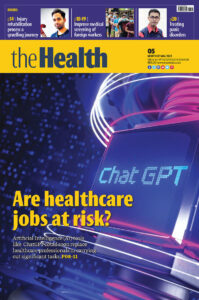Whether to save lives or as cosmetic purposes, space innovations and inventions have aided healthcare

BY ZULKIFLI AHMAD
Space – the final frontier. For Trekkies, they know these were the opening words of Captain James Kirk in the 1960s popular science fiction series.
It is not an exaggeration to say that a twist of fate had caused space and innovation to exist together for the good of mankind generally and daily utilities specifically.
Necessity is the mother of all inventions. Nothing can be further than the truth than the voracious need to invent things to function and exist in the forbidding thin air of space. Two aspects we can give attention to – the remarkable collaboration between the space agencies and private concerns and the use of innovations for daily use meant for space.
However, space innovations and inventions are identified to be used in other fields. Could there have been cases when these innovations were ignored or did not get the necessary attention and possible missed opportunities?
Imagine a group of archaeologists who in 2021 unearthed treasures including ancient manuscripts with cryptic messages detailing thousands of futuristic innovations. Scientists would be able to unravel and decipher the notes and identify some of the inventions like locomotives, bullet trains, jet propulsion, jet fuel, etc.
There are also a myriad of inventions the scientists are unable to say for what purpose.
But if a group of archaeologists in the year 2221 found the same manuscripts, scientists will be able to identify many of the inventions not done by 2021 scientists and the former will be familiar with say, inventions done in 2105.
Similarly, there are methodologies that space innovations and inventions that can be identified to be suitable for other non- space use which will be explained later.
Why are space innovations more efficacious?
- Philosophy
Everyone involved in the space program are indoctrinated with the thinking they are forging in an undertaking in unchartered frontier. This itself would create a mindset that only the best will do to function in an unfamiliar world.
- Intense Competition
When space exploration was done by the USA and Russia, the competition although only between two countries, was intense and sense of patriotism played its uncompromising role. It was during this period many space innovations occurred. Today, more countries are entering the race including Africa and UAE.
- Capacity
A plethora of resources were put into space innovation and it is about what best money can buy by public and private enterprises. They were top notch expertise, laboratories, equipment that no one can afford to settle for less.
- “Guided” Thinking Out Of The Box
Brainstorming sessions would have ventured into ‘out of this world situations’ so to speak. Totally unrelated ‘ideas’ started to be put on the table which then materialised into new innovative products for space but improvised for daily use.
- Intensity
As astronauts’ lives are at stake in a place with no possible way of being rescued, experimentations are carried out more intensely to ensure resilience and effective functioning.
Space Innovations being used in other fields
Freeze-dried foods
During long space missions freeze-dried foods are crucial for astronaut’s nutrition. These foods are very light, and they retain their nutritional value. Once prepared for eating, they are also easier and more palatable to eat than the former original sources that were packed into squeeze tubes.
Camera phones
About three decades ago NASA had invented a light, miniature imaging system that required minimum energy to take high quality pictures from space. This technology has become a standard feature in cell phones today.
Firefighting equipment
The polymers for use in space suits have led to creating flame-retardant, heat-resistant suits for firefighters. Newer suits feature circulating coolant to keep firefighters from the overwhelming heat and advanced breathing systems as used in astronaut life support systems.
Shock absorbers for buildings
Shock absorbers used today to protect bridges and buildings in areas prone to earthquakes were originally designed to protect equipment during space shuttle launches.
Solar cells
NASA has invented, and consistently improved, photovoltaic cells, sharing the findings with other companies to enhance the technology.
Water filtration
It was in the 1970s that NASA developed filtration systems used in iodine and cartridge filters to ensure astronauts can have safe, tasteless water. This filtering technology is now standard feature worldwide.
Baby formula
NASA scientists were searching fora recycling agent to use during long space missions and found a nutritious, algae-based vegetable oil which is now an additive in many infant formulas. It consists of two essential fatty acids that cannot be synthesised by the human body.
Whether to save lives, facilitate or as cosmetic purposes space innovations and inventions have aided healthcare.
Insulin pump
Astronauts’ vital signs in space need to be monitored and these monitoring systems have been adapted to regulate blood sugar levels and release insulin as needed.
LASIK
During LASIK surgery, a device tracks a patient’s eye positions for the surgeon. This technology was originally used to track astronauts’ eyes during periods in space in order to assess how weightlessness affects humans’ frames of reference.
CAT scans
The technology that makes CAT scans and MRIs was from NASA’s digital signal technology, originally used to recreate images of the moon during the Apollo missions.
Artificial limbs
Artificial human limbs that we see now which are more durable, functional, comfortable and life-like, are innovations originally designed for space vehicles, including robotic sensors, artificial muscle systems, temper foam, diamond-joint coatings.
Invisible braces
A material used to invent invisible braces was originally created to protect radar equipment without blocking its signal.
Aspirations of ESG Vision
It is ESG Vision’s hope that there will continue to be more space innovations and inventions ‘collateral’ benefits for the other industries including in healthcare and sustainability and daily use. There needs to be collateral or parallel research for innovation from space to be effectively identified and utilised in other fields.
To miss these breakthroughs will be missed opportunities that can make difference between lucrative outcomes and lost opportunities and between saving lives and lives lost. — The Health
Zulkifli Ahmad is the founder of ESG Vision, a think tank advocating ideas and actions on sustainability








